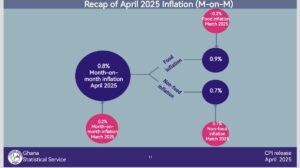
By Andy Sena AGBLEY & Walter Kwaku AWUAH
From the later part of 2006, the news about a subtle rejection of the 20-pesewa coin started brewing; the central bank of Ghana, led by Dr. Paul Amoafo Acquah, in July 2007, undertook a bold monetary policy reform: the redenomination of the cedi.
The aim was to simplify transactions, restore confidence in the currency, and improve efficiency in payments (BoG, 2007 & PwC Ghana, 2007).
Four zeros were slashed off the currency, introducing a new Ghana cedi (GH?) equivalent to 10,000 old cedis. The transition also ushered in coins of smaller denominations, including 1, 5, 10, 20, and 50 pesewas to facilitate transactions with precision, so to say.
Despite the initial optimism and nationwide sensitisation campaigns, smaller denomination coins soon fell into disuse as they steadily lost public acceptance.
By 2010, a growing number of consumers and vendors were refusing to accept coins below 10 pesewas, citing their perceived insignificance and inconvenience, and yes, in reality, the coins were too small in nature.
However, more than a decade later, one overlooked consequence of this policy has silently contributed to a persistent economic challenge – inflation driven by the rejection of smaller denomination coins.
This seemingly minor behavioural trend has evolved into a broader economic concern, subtly but persistently fuelling inflationary pressures across the economy.
Today, coins such as the 5, 10 and even 20 pesewas have become virtually obsolete in everyday transactions. Vendors often refuse them, customers avoid them, and businesses no longer price goods or services to reflect their use, oh before we forget, the Banks no longer have these coins in their vault.
Amoako-Agyeman & Mintah (2014) found that informal sector workers, especially market traders, quickly abandoned the smaller denominations due to difficulty in handling, storage issues, and customer resistance.
The phrase “the value is the same,” which was popularised during the reform campaign, lost its practical meaning as prices gradually adjusted upward. This silent but systemic rejection has distorted market-pricing mechanisms.
Public rejection of small denomination coins
Anecdotal evidence and public discussions, including recent radio debates, suggest a near-systemic rejection of coins below 50 pesewas. Many consumers and vendors view these denominations as either burdensome or irrelevant, resulting in price rounding practices among vendors.
The 20-pesewa coin, once a viable pricing tool, now often refused outright or ignored as negligible change. Items previously sold at 15 or 18 pesewas now priced at 20 or 50 pesewas. This phenomenon, repeated across millions of transactions daily, has led to:
- Upward Price Stickiness: Prices rarely adjust downward due to lack of coins to facilitate reductions.
- Distorted Market Pricing: Businesses are incentivised to set prices based on available denominations rather than market value.
- Erosion of Purchasing Power: Consumers face disproportionately higher prices, especially on basic goods like sachet water, kenkey, and lorry fares.
not necessarily due to cost-push inflation, but partly to avoid transactions requiring small change. The market thus gradually rounds up prices, contributing to a general upward creep in the price level (Aryeetey & Baah-Boateng, 2015). A 2024 article on Ghana web noted that a ball of kenkey that cost 10 pesewas in 2007 now sells for GHS6, a 5900% increase.
Small denominations, big impact
Inflation is often understood as being driven by macroeconomic fundamentals such as money, supply, growth, exchange rate volatility, and fiscal deficits. However, price rigidity and rounding behaviours, public perceptions induced by the rejection of low-denomination coins form a microeconomic contributor to inflation.
The situation represents what economists term menu cost-induced inflation, a scenario where prices increase not necessarily due to supply-side shocks, but due to behavioural frictions in the pricing mechanism (Mankiw, 1985).
This subtle inflation eats away at consumer purchasing power. A 20-pesewa increase in basic goods may seem insignificant in isolation, but when compounded across multiple purchases daily and monthly, it results in tangible income erosion, especially for low-income households.
Furthermore, it undermines confidence in the currency’s divisibility and usability, which are some of the essential thoughts behind the currency redenomination in the first place. When citizens deem portions of their legal tender as effectively worthless, it signals a weakening public trust in the monetary system.
A gradual drift toward hyperinflation?
Today, it is the 20 pesewa; tomorrow it could be the 50 pesewa, and soon after, the GH?1 coin. This pattern is not speculative; it reflects Ghana’s recent history. The 1, 5, 10 pesewa coins, once commonly used, have now all but disappeared from circulation and consumer memory.
The Ghanaian economy is steadily losing its lower rungs of pricing elasticity, or to put it plainly, if this progression continues unchecked, Ghana risks drifting toward a situation where the lowest transactional denomination becomes GH?5 since the BoG is fading out the 1 and 2 cedis notes – a hallmark symptom of hyperinflation.
Though this evolution may not yet meet the classic definition of hyperinflation, which entails monthly inflation exceeding 50%, the trend contributes to what can be termed creeping hyperinflation: the erosion of small-value transactions leading to disproportionate price jumps in essential goods (Hanke & Krus, 2013).
As coins fall out of use and replaced by higher denominations, consumers will face rising costs for even basic goods and services. Sachet water, for instance, once priced at 5 or 10 pesewas, now costs 40 pesewas as at the time of writing.
In a properly functioning price system, it could justifiably cost 2 pesewas, but that is no longer viable due to the impracticality of dealing with these smaller coins, which have effectively faded away.
Theory Meets Reality
Just before the policy rollout, this writer recalls a classroom discussion in 2007 during a Corporate Finance lecture, where we were tasked to project the long-term effects of the redenomination exercise.
A few students, drawing on behavioural economics, anticipated that if coins were culturally undervalued, they would steadily vanish from use, the resulting price distortion could quietly fuel inflation. Today, those predictions are playing out, a clear testament to the interplay between monetary policies, public psychology, and pricing norms.
Policy Considerations
While price control comes to mind and might appear as an immediate solution, like setting fixed prices for low-cost goods like kenkey and sachet water for instance, such interventions are historically fraught with enforcement challenges and unintended consequences (Tanzi, 1991). The BoG and government may consider a more sustainable approach such as:
- Reintroduce public education on the value of small denominations. Create incentives for businesses to accept and return exact change.
- Re-mint higher quality coins with better physical characteristics, such as size of the coins.
- Promote micro-digital payments using mobile money or QR codes, enabling precise pricing without the need for coins.
- Regulate pricing for items such as sachet water and public transportation to reflect rational price points (e.g., 5 or 10 pesewas).
- Monitor inflation in sectors where price rounding is most prevalent.
- Commission regular studies to track coin usage trends.
The central bank, the finance ministry, the ministry of trade and general policymakers need to appreciate the connection between public sentiment, transactional behaviour, and long-term monetary stability. Dismissing the coin issue as inconsequential slips the structural risk it poses to economic inclusiveness and price stability
Conclusion
Perhaps the cedi redenomination was necessary; however, like any structural change, its unintended consequences continue to unfold. The rejection of small coins may seem like a minor inconvenience, but in aggregate, it is a powerful and largely invisible driver of inflation in Ghana.
With the 1, 5, and 10 pesewas already in disuse in the economy, the recent growing rejection of the 20 pesewa is a silent, yet powerful force nudging prices upward, undermining economic equity and distorting market signals.
It is time for policymakers, economists, and civil society to pay closer attention to this subtle form of inflation and act decisively to protect the integrity of Ghana’s currency.
References
Aryeetey, E., & Baah-Boateng, W. (2015). Understanding Ghana’s recent inflation dynamics. Institute of Statistical, Social and Economic Research (ISSER), University of Ghana.
Amoako-Agyeman, K. & Mintah, E. (2014). “Impact of Currency Redenomination on an Economy: An Evidence of Ghana.” Academia.edu.
Bank of Ghana. (2007). Redenomination of the Cedi: Frequently Asked Questions. Retrieved from https://www.bog.gov.gh
Hanke, S. H., & Krus, N. (2013). World Hyperinflations. Cato Institute Working Paper.
Mankiw, N. G. (1985). Small menu costs and large business cycles: A macroeconomic model of monopoly. Quarterly Journal of Economics, 100(2), 529-538.
PricewaterhouseCoopers Ghana (2007). “Redenomination of the Cedi: Implications for Businesses.”
Tanzi, V. (1991). Inflation and the personal income tax: An international perspective. International Monetary Fund.
The post The rejection of the 20-pesewa coin: A silent driver of inflation appeared first on The Business & Financial Times.
Read Full Story








![‘I’m a Supplier’- Interdicted police officer admits selling opioids to youth [Video]](https://sportal365images.com/process/smp-images-production/pulse.com.gh/05052025/fc3b0efb-cfe0-47e6-9110-1dafcd7a834d.png)







Facebook
Twitter
Pinterest
Instagram
Google+
YouTube
LinkedIn
RSS